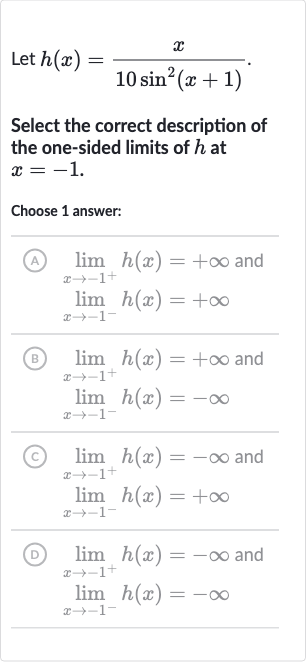Full solution
Q. Let .Select the correct description of the one-sided limits of at .Choose answer:(A) and (B) and (C) and (D) and
- Given Function: . We need to find the limits as approaches from the right () and from the left ().
- Approaching from Right: For approaching from the right (+), we look at values of that are just greater than . As gets close to , gets close to . Since , will also approach . The denominator of will approach , making grow without bound.
- Approaching from Left: For approaching from the left ), we look at values of that are just less than . Similar to the previous step, as gets close to , gets close to . Again, will approach , and the denominator of will approach , making grow without bound.
- Determining Sign of Infinity: We need to determine the sign of the infinity for the limits. Since is in the numerator, as approaches from the right, is negative and getting closer to , so the numerator is negative. The denominator is always positive because it's . Therefore, the limit from the right is negative infinity.
- Final Limits: Similarly, as approaches from the left, is still negative and getting closer to , so the numerator is negative. The denominator is positive because it's . Therefore, the limit from the left is also negative infinity.
More problems from Compare linear and exponential growth
QuestionGet tutor help
QuestionGet tutor help
QuestionGet tutor help
QuestionGet tutor help
QuestionGet tutor help
QuestionGet tutor help
QuestionGet tutor help

